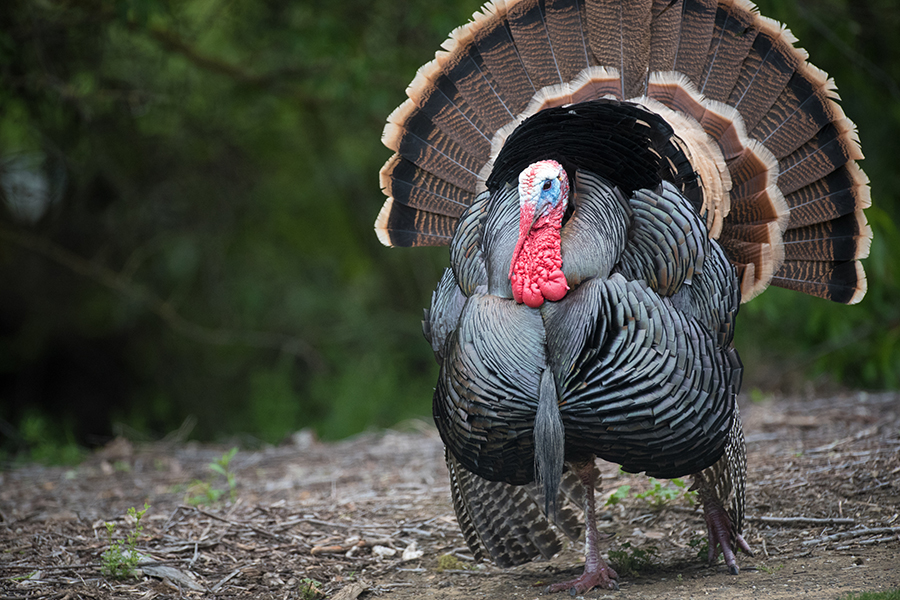Anyone who’s hunted wild turkeys in the spring knows there’s no thrill like the rarefied success of gobbling a strutting tom, or male turkey, into shotgun range, its chest puffed out, tail feathers fanned and bright head beaming maraschino red as it searches for a phantom hen.
What that hunter might not know, however, is that the Treasure State was void of wild turkeys until 1954, when Montana Fish, Wildlife and Parks (back then it was called the Department of Fish and Game) released 13 Merriam’s turkeys from Colorado into the Judith Mountains of central Montana. That initial transplant was followed up with the release a year later of 18 Merriam’s turkeys from Wyoming, while another 26 birds were released in southeastern Montana in 1956 and 1957, according to the agency.
That marked the last time stock from outside Montana was transplanted to grow the Merriam’s turkey population, but it was also during that time period that turkeys of the Eastern subspecies were illegally released in the Flathead Valley, according to FWP. Eastern turkeys are native to the hardwood forests of the eastern U.S. — habitats much different than those of the Rocky Mountain West.
Today, the Merriam’s turkey represents one of Montana’s most prized upland game birds, and a flock of wild turkeys moving across a hillside studded with ponderosa pine has become a permanent addition to Montana’s wildlife and hunting scene. Eastern turkeys share similar characteristics, but can be differentiated by the tail feathers — the Merriam’s are tipped with white while the Eastern is festooned with chestnut-colored tips.
Merriam’s have expanded their range in Montana both through transplants and natural movement, while the Easterns have remained in the northwestern corner of the state. The turkey hunting season opens April 13 and runs through May 19.
Tips for Hunting Gobblers in the Spring
Be in the woods by the crack of dawn because this is when the breeding-age toms begin sounding off with lusty gobbles audible half a mile away on a still morning. Breeding-age toms do most of their gobbling during the first two hours of daylight, but during the height of the mating season, an occasional gobble may be heard at any time of the day.
When calling to a tom on the roost early in the morning, a couple of soft, sleepy clucks work better than the hen yelp. A tom is reluctant to respond to a love yelp so early in the morning.
Whether you wear camouflage or not, your clothing should blend with the foliage around you. Although some hunters swear by facial camouflage and clothing, other good hunters are inclined to believe one’s movements spook turkeys.
After a gobbler sounds, try to move within 200 yards of his position and then choose a stand in a fairly open area. As a general rule, turkeys avoid thickets that could conceal an enemy. A turkey likes a certain amount of ground cover within the timber to make it feel secure. However, the ground cover must be open enough to instantly afford the turkey good vision, allow it to walk without touching or coming into bodily contact with thick ground growth and assure it quick wing action and passage if need be. Turkeys are like any other animals — their behavior is mostly directed toward survival. Once you are on a stand, sit still and be patient.
Try to get uphill and on the same ridge as a gobbler. It’s the easiest place to call from. Turkeys are a lot easier to call uphill than downhill.
When selecting a calling site, look for a tree with a good thick base. Sit in front of it, and use it as a backrest.
Weather conditions play a big part in the success of the spring gobbler hunt. A day that starts with a clear, cool morning and no wind is a good choice for hunting turkeys. Cold weather — especially when coupled with new snow — usually dampens the amorous attitudes of gobblers, making calling almost useless. If such weather conditions occur, stay home, practice your calls, read up on the life history of the wild turkey and hope for a better day.
Rifles are not a legal weapon for the spring season; most turkey hunters prefer using a 12-gauge shotgun with a full choke and using No. 2 or No. 4 shot. Others prefer a bow. Turkeys are big, tough birds, and their vital organs are tucked away beneath heavy, metallic-colored feathers. Breeding-age toms also have what is called a breast sponge, which acts like a flak jacket. It’s a large mass of fatty tissue that helps them remain in prime physical condition during the breeding season. Wild turkeys also have blinding speed afoot, and even a broken wing seldom results in a turkey in the oven. Because a turkey’s body is nothing less than a miniature armored-tank, preferred areas to shoot at are head and neck.
Happy hunting.
